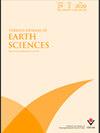The first application of the luminescence surface exposure dating method on active fault scarps in the Western Anatolia extensional province: the Manisa Fault as an example
IF 1.1
4区 地球科学
Q3 GEOSCIENCES, MULTIDISCIPLINARY
引用次数: 0
Abstract
: While there has been significant research on the dating of paleoearthquakes using methods such as surface cosmogenic dating, and trench-based luminescence or radiocarbon dating, this paper focuses on implementing an alternative surface dating method using a fault scarp-based optically stimulated luminescence (OSL) dating approach. Hence for the first time, we investigated the Pleistocene to Holocene earthquake cycle of the Manisa Fault, one of the dip-slip active faults of the Western Anatolia extensional province, utilizing novel OSL surface exposure techniques. In this technique, OSL bleaching profiles on the fault surface are directly related to the exposure of the fresh fault scarps that are produced by earthquakes. The results indicate that the Manisa Fault is responsible for at least six surface rupturing earthquakes since the Holocene, occurring at 154 ± 22 year (E6: LSD3), 416 ± 48 year (E5: LSD4), 1103 ± 82 year (E4: LSD5), 2067 ± 138 year (E3: LSD6), 5376 ± 48 year (E2: LSD7), and 6432 ± 218 year (E1: LSD8). Our results of the first use of this novel method on the Manisa Fault are in agreement with prior cosmogenic dating of fault scarps and trench-based paleoseismological chronological data, and we conclude that the OSL surface chronology is a promising alternative for fault scarp dating of paleoearthquakes.发光地表暴露测年法在西安纳托利亚伸展省活动断崖上的首次应用:以马尼萨断裂带为例
虽然已有大量研究采用地表宇宙成因测年、海沟发光测年或放射性碳测年等方法对古地震进行测年,但本文的重点是采用基于断层崖的光学激发发光测年方法实现一种替代的地表测年方法。因此,我们首次利用新的OSL地表暴露技术研究了西安纳托利亚伸展省倾滑活动断层之一马尼萨断层的更新世至全新世地震旋回。在这种技术中,断层表面的OSL漂白剖面与地震产生的新断层陡坡的暴露直接相关。结果表明,全新世以来,马尼萨断裂至少造成了6次地表破裂地震,分别发生在154±22年(E6: LSD3)、416±48年(E5: LSD4)、1103±82年(E4: LSD5)、2067±138年(E3: LSD6)、5376±48年(E2: LSD7)和6432±218年(E1: LSD8)。我们在马尼萨断层上首次使用这种新方法的结果与先前断层崖的宇宙形成测年和基于沟的古地震年代学数据一致,我们认为OSL表面年代学是断层崖古地震测年的一个有希望的替代方法。
本文章由计算机程序翻译,如有差异,请以英文原文为准。
求助全文
约1分钟内获得全文
求助全文
来源期刊

Turkish Journal of Earth Sciences
地学-地球科学综合
CiteScore
2.40
自引率
10.00%
发文量
6
审稿时长
6 months
期刊介绍:
The Turkish Journal of Earth Sciences is published electronically 6 times a year by the Scientific and Technological Research
Council of Turkey (TÜBİTAK). It is an international English-language journal for the publication of significant original recent
research in a wide spectrum of topics in the earth sciences, such as geology, structural geology, tectonics, sedimentology,
geochemistry, geochronology, paleontology, igneous and metamorphic petrology, mineralogy, biostratigraphy, geophysics,
geomorphology, paleoecology and oceanography, and mineral deposits. Contribution is open to researchers of all nationalities.
 求助内容:
求助内容: 应助结果提醒方式:
应助结果提醒方式:


